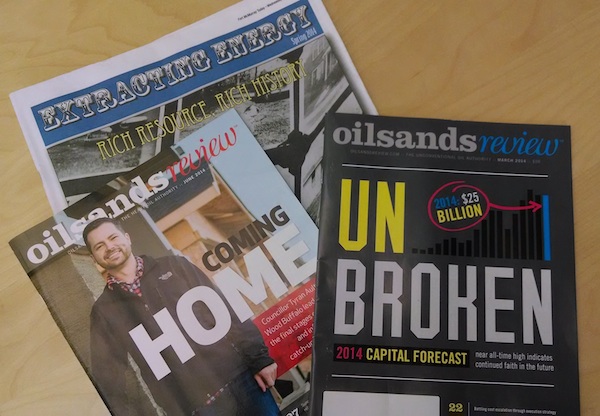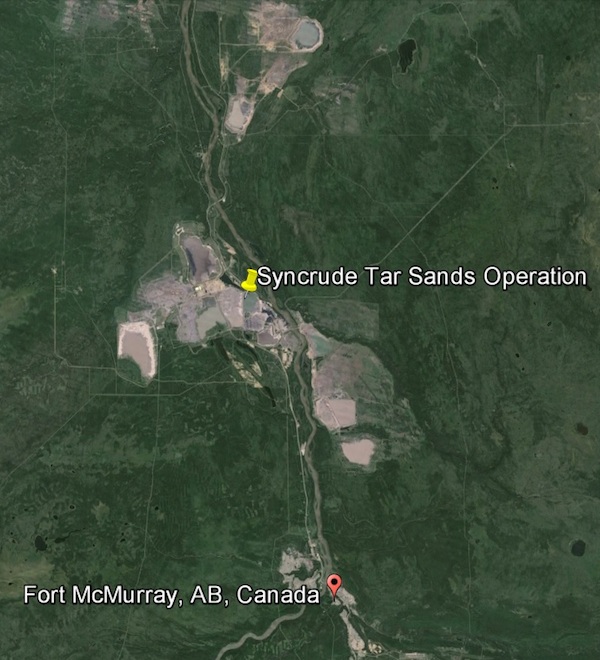In late June, a team of RAN staff travelled to Fort McMurray in Alberta, Canada to participate in the Tar Sands Healing Walk, which is organized and hosted by members of the local First Nations Communities. Walking amidst the tar sands destruction was a humbling and powerful experience.
This blog post is one of a series, sharing our impressions and reflections.
Our journey in Alberta began in Fort McMurray, a boomtown where the international oil industry has set up a base of operations from which to conduct tar sands extraction. The scale of the industry anchored in Fort McMurray is difficult to overstate: the town sits on one of the world’s largest oil deposits, the Athabasca tar sands. The extraction of Alberta’s tar sands constitutes the world’s biggest industrial project, and massive mining operations directly abut Fort McMurray.
We landed at the brand new Fort McMurray international airport, where workers were putting the finishing touches on the terminal’s décor, as if the place had been quickly constructed in anticipation of our arrival. Immediately, signs of the tar sands-driven boom were apparent; gift shops featured oil sands tee shirts and advertisements announced new direct international flights to Las Vegas, enabling well-paid oil workers to quickly spend their paychecks on gambling and entertainment.
 More than 80% of Canada’s tar sand workers are male, and Fort McMurray was full of bulky guys. On the plane, I overheard a pair of oil workers talking about how they had gained over 100 pounds while living in company-provided housing at a tar sands refinery, a by-product of boredom and sedentary machine-operation. As if to justify the weight gain, the workers then turned their conversation to the “couple of houses” each had bought with their tar sands earnings.
More than 80% of Canada’s tar sand workers are male, and Fort McMurray was full of bulky guys. On the plane, I overheard a pair of oil workers talking about how they had gained over 100 pounds while living in company-provided housing at a tar sands refinery, a by-product of boredom and sedentary machine-operation. As if to justify the weight gain, the workers then turned their conversation to the “couple of houses” each had bought with their tar sands earnings.
Many of Fort McMurray’s workers seemed focused on buying real estate with oil profits; the town was awash in oil industry publications that combined breathless accounts of lucrative tar sands expansion, advertisements for mining companies, and tips on homeownership and real estate. According to the Canadian Association of Petroleum Producers, capital investments in the Canadian tar sands have jumped more than 400% since 2006, stretching the municipality’s resources and skyrocketing population and property values in Fort McMurray. Expansion, growth, money, and oil are the watchwords of the day.
 On the edge of town we visited the Oil Sands Discovery Centre, a shrine to the technological process of extracting and refining the tar sands. Sponsored by the Albertan government with heavy support from industry, the Discovery Centre was most remarkable for what it was not included in its displays. As in Fort McMurray and the tar sands industry more broadly, the Oil Sands Discovery Centre lacked any acknowledgement of the climate impacts stemming from the tar sands. It was as if the oil industry town existed in an alternative reality where climate change did not exist and endless expansion of tar sands mining was completely unopposed by the global community. This was a step beyond climate denialism; it was an outright refusal to even recognize that the concept of climate change exists.
On the edge of town we visited the Oil Sands Discovery Centre, a shrine to the technological process of extracting and refining the tar sands. Sponsored by the Albertan government with heavy support from industry, the Discovery Centre was most remarkable for what it was not included in its displays. As in Fort McMurray and the tar sands industry more broadly, the Oil Sands Discovery Centre lacked any acknowledgement of the climate impacts stemming from the tar sands. It was as if the oil industry town existed in an alternative reality where climate change did not exist and endless expansion of tar sands mining was completely unopposed by the global community. This was a step beyond climate denialism; it was an outright refusal to even recognize that the concept of climate change exists.
In place of the gaping hole where climate concerns should have been, the Oil Sand Discovery Centre touted Fort McMurray’s incredibly ironic ban on single-use plastic bags, and offered an appeasing video insinuating that oil industry reclamation efforts are akin to the millennia of sacred land stewardship practiced by Indigenous First Nations groups. While we immediately smelled a rat in the oil industries claims of reclamation, it wasn’t until we joined the Athabasca Chipeywan and Mikisew Cree First Nations that the abject hideousness of industry claims came into focus.
When we left the world of Fort McMurray’s oil settlers and joined First Nation host communities at the Tars Sands Healing walk, what we heard and saw laid bare the poisonous horror that lurks beneath the sheen of Alberta’s lucrative tar sands boom and industry’s expansionist dreams.
Part Two, “Indigenous Nightmares”, will be posted next week.
Photos:
1. Visitors at the Oil Sands Discovery Centre in Fort McMurray.
2. Oil industry magazines predict growth for Fort McMurray and tar sands mining.
3. Fort McMurray is dwarfed by nearby tar sands mines.
4. An ironic sign at the Oil Sands Discovery Centre.